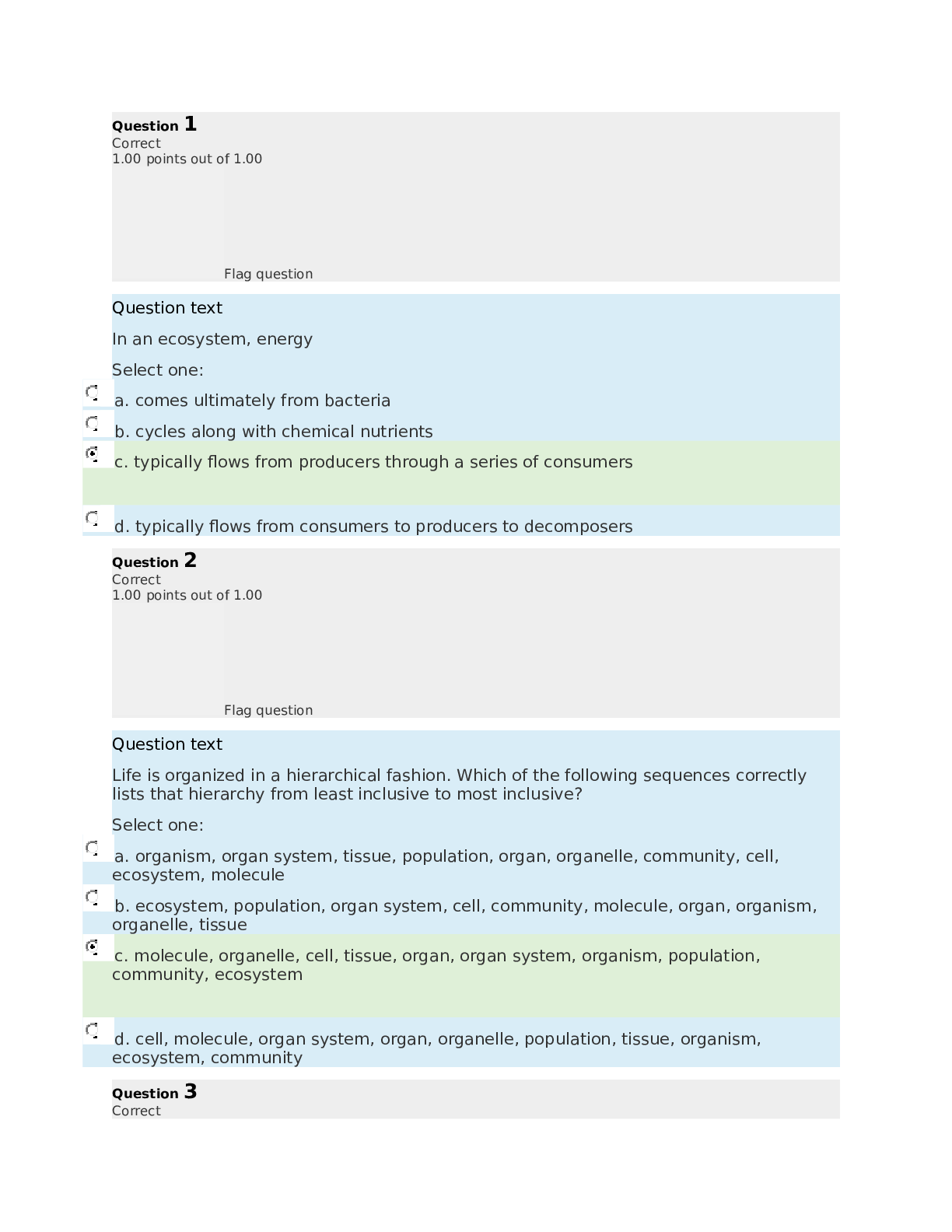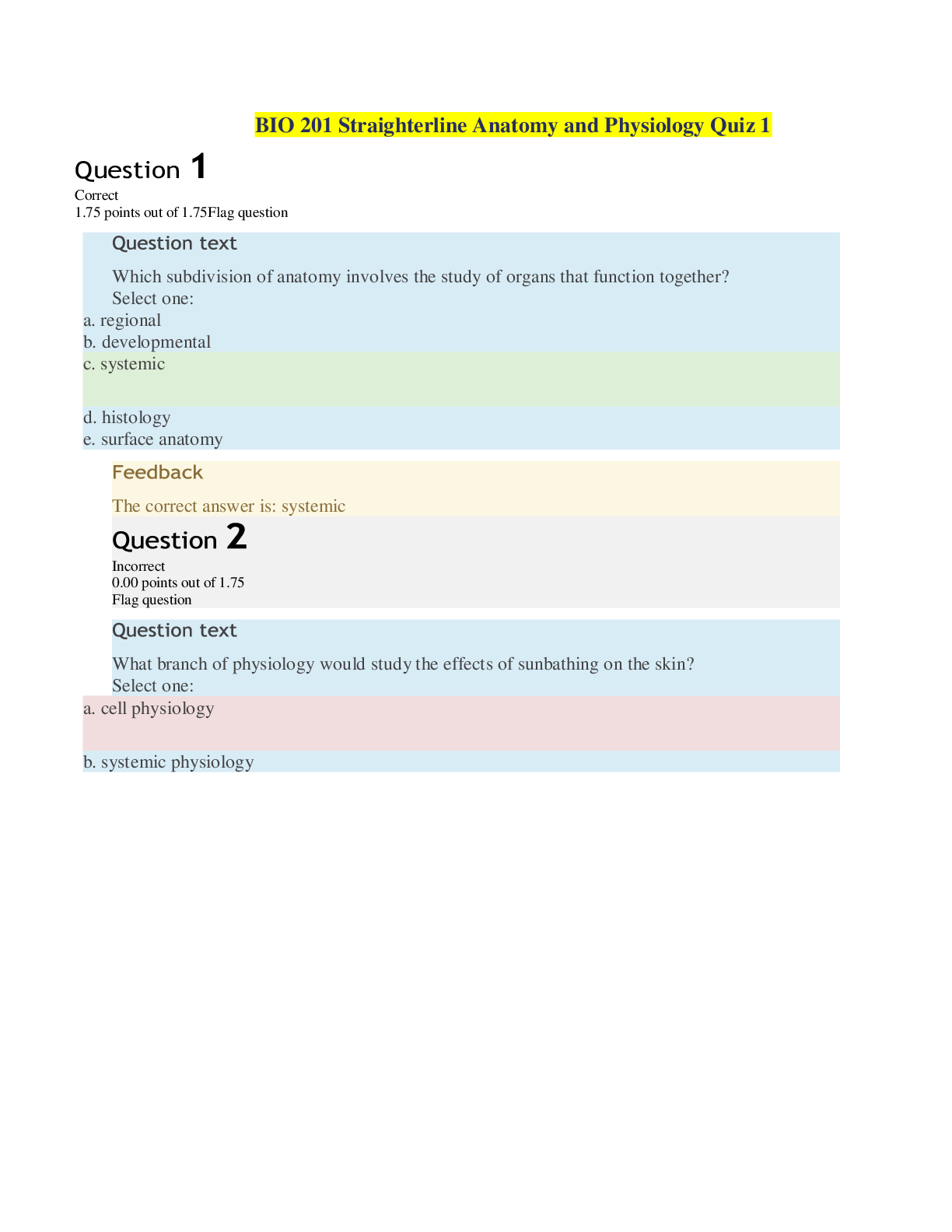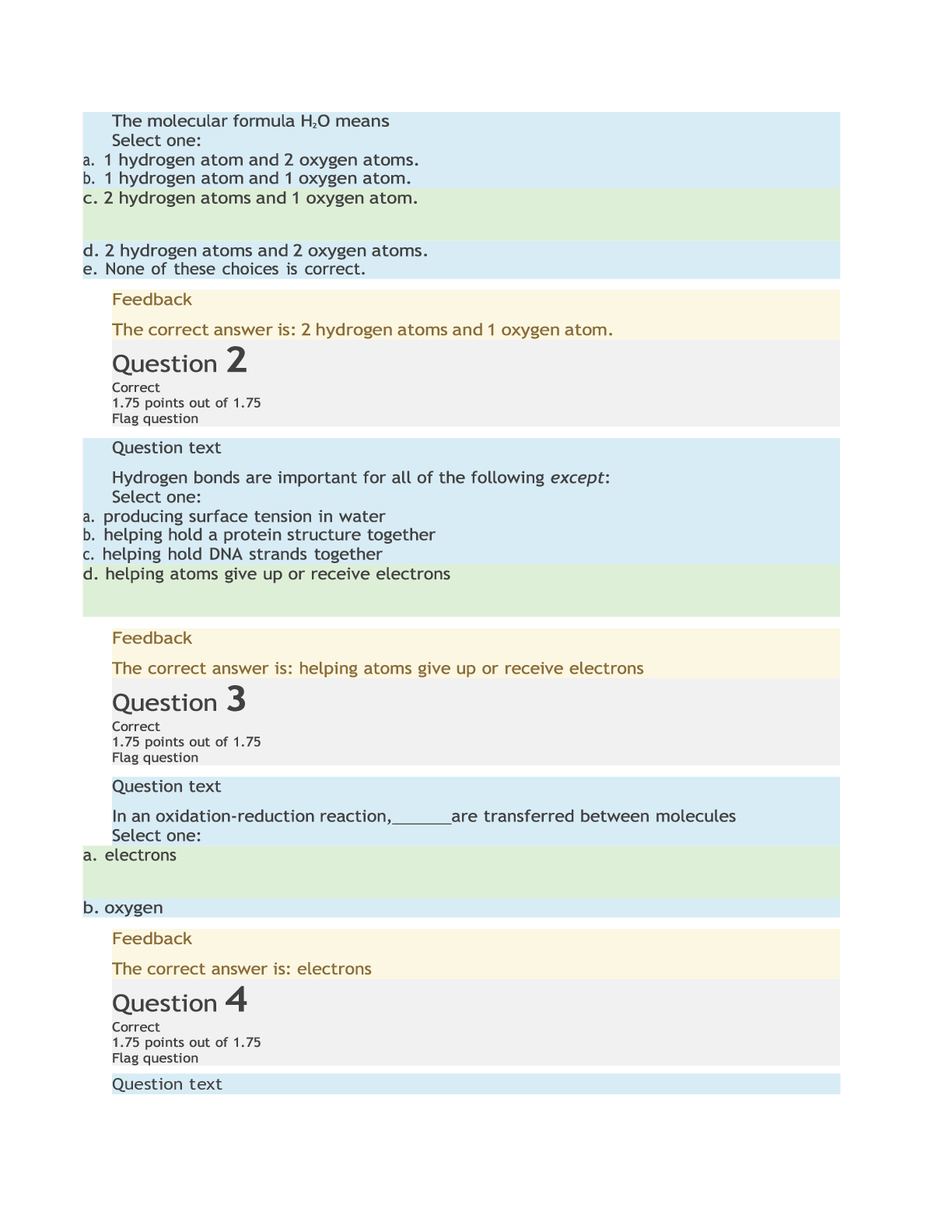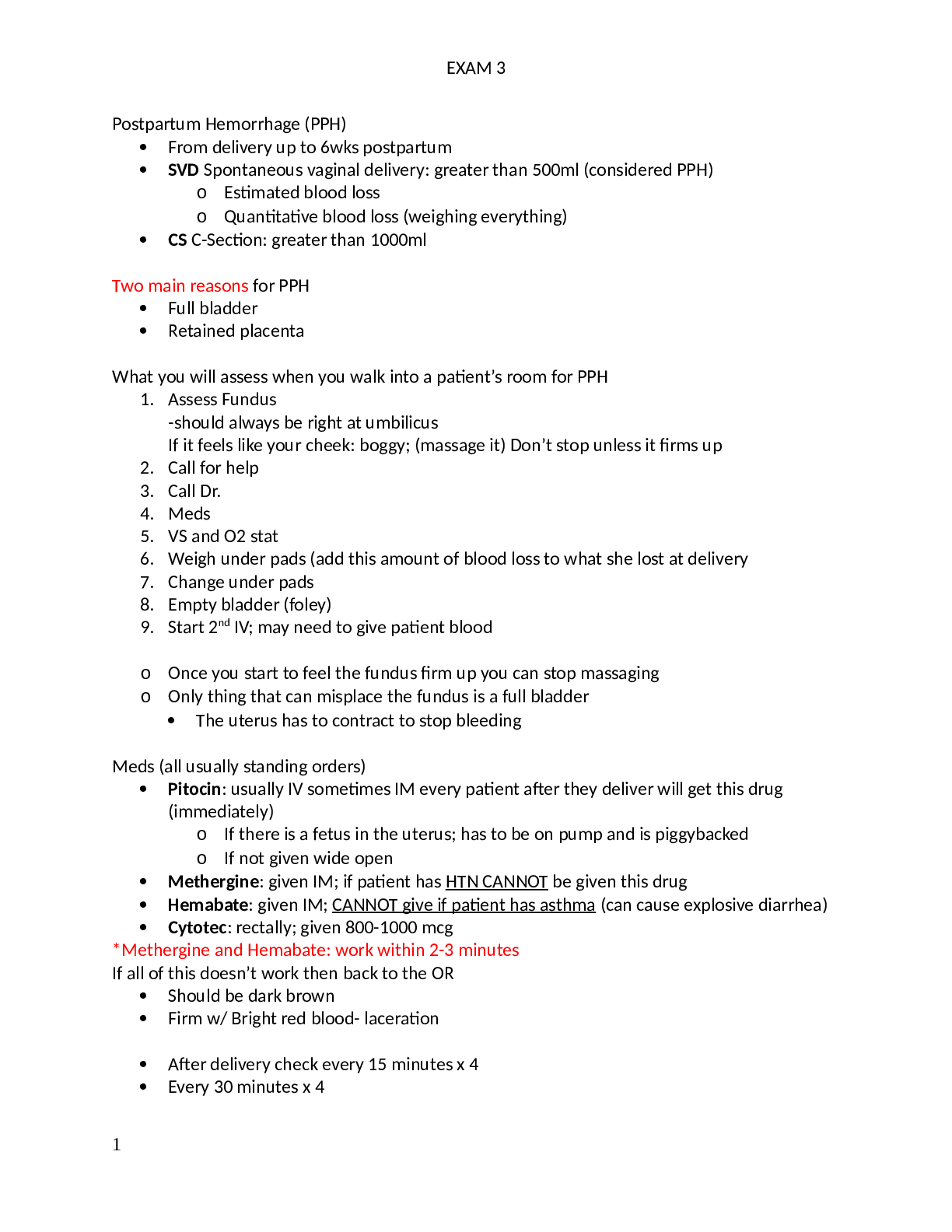Anatomy > EXAM > ANATOMY AND PHYSIOLOGY I quiz 11 (GRADED) / BIO201_MH_V3 Topic 11: Functional Organization of Ne (All)
ANATOMY AND PHYSIOLOGY I quiz 11 (GRADED) / BIO201_MH_V3 Topic 11: Functional Organization of Nervous Tissue (UPDATED 2021) | 100% VERIFIED | Straighterline
Document Content and Description Below
•BIO201_MH_V3 •Topic 11: Functional Organization of Nervous Tissue Question 1 Correct 1.75 points out of 1.75 Flag question Question text When repolarization of a neuron is complete, the Sel... ect one: a. neuron dies. b. neuron regenerates. c. cell no longer has a potential difference across its membrane. d. original polarity of the neuron is restored. e. neuron is no longer excitable. Question 2 Correct 1.75 points out of 1.75 Flag question Question text A series of local potentials causes the membrane potential to move to -80 mV. Predict the result. Select one: a. threshold is reached b. depolarization occurs c. the neuron is hyperpolarized d. information of frequency is needed to predict the result e. the neuron releases neurotransmitter in response Question 3 Correct 1.75 points out of 1.75 Flag question Question text Voltage-gated sodium channels are sensitive to changes in the extracellular concentration of Select one: a. potassium ions. b. proteins. c. sodium ions. d. chloride ions. e. calcium ions. Question 4 Correct 1.75 points out of 1.75 Flag question Question text Chemical synapses are characterized by Select one: a. the release of neurotransmitter by the presynaptic terminal. b. connexons that connect the pre- and postsynaptic cells. c. the presence of receptors for neurotransmitters on the presynaptic terminal. d. the absence of gap junctions. e. receptors located only on the presynaptic terminal. Question 5 Correct 1.75 points out of 1.75 Flag question Question text When two action potentials arrive simultaneously at two different presynaptic terminals that synapse with the same postsynaptic neuron, Select one: a. the direction of the action potential is reversed. b. temporal summation occurs. c. spatial summation occurs. d. hyperpolarization occurs. e. threshold is never reached. Question 6 Correct 1.75 points out of 1.75 Flag question Question text Which of the following events is NOT a characteristic of an action potential? Select one: a. The plasma membrane becomes highly permeable to sodium ions and depolarization results. b. As sodium ions enter, the inside of the plasma membrane becomes more negative. c. At the peak of depolarization, sodium channels begin to close and potassium channels open. d. In repolarization, potassium ions flow out of the cell. e. Action potentials occur according to the all-or-none principle. Question 7 Correct 1.75 points out of 1.75 Flag question Question text If the ECF around a nerve cell is replaced with an isotonic saline solution that contains potassium ions and other solutes at concentrations very close to the ECF concentrations of a normal cell, the result is Select one: a. no resting membrane potential. b. hyperpolarized membrane. c. depolarized membrane. d. a resting membrane potential close to its normal value. e. None of these choices is correct. Question 8 Correct 1.75 points out of 1.75 Flag question Question text Identify structure "A" on the neuron. Select one: a. Schwann cell b. Node of Ranvier c. neuron cell body (soma) d. dendrites e. axon Question 9 Correct 1.75 points out of 1.75 Flag question Question text The junction of a neuron with another cell is a/an Select one: a. synapse. b. ganglion. c. receptor. d. effector. Question 10 Correct 1.75 points out of 1.75 Flag question Question text Identify the type of synapse that includes a presynaptic cell, synaptic cleft, and postsynaptic cell. Select one: a. chemical b. electrical c. direct d. indirect e. neurotransmitter Question 11 Correct 1.75 points out of 1.75 Flag question Question text Which of the following is NOT true about astrocytes? Select one: a. They can wall off an injury site to prevent spread of inflammation. b. They can prevent toxic substances from entering brain tissue. c. They can release chemicals that promote formation of synapses. d. They can aid in the regeneration of injured neurons. Question 12 Correct 1.75 points out of 1.75 Flag question Question text Protein synthesis in neurons occurs in Select one: a. axons. b. dendrites. c. cell bodies or soma. d. terminal boutons. e. node of Ranvier. Question 13 Correct 1.75 points out of 1.75 Flag question Question text Gaps or interruptions in the myelin sheath are called Select one: a. internodes. b. tight junctions. c. neurofilaments. d. nodes of Ranvier. e. gap junctions. Question 14 Correct 1.75 points out of 1.75 Flag question Question text A neuron that conducts pain sensations to the central nervous system would be classified as a(n) Select one: a. motor neuron. b. sensory or afferent neuron. c. efferent neuron. d. association neuron. e. interneuron. Question 15 Correct 1.75 points out of 1.75 Flag question Question text Hydrocephaly is a condition whereby cerebrospinal fluid accumulates around the brain. What supportive cells continue CSF production despite it backing up in the subarachnoid space? Select one: a. astrocytes b. microglial cells c. oligodendrocytes d. macrophages e. ependymal cells Question 16 Correct 1.75 points out of 1.75 Flag question Question text The central nervous system includes the Select one: a. ganglia. b. spinal cord. c. spinal nerves. d. cranial nerves. e. sensory receptors. Question 17 Correct 1.75 points out of 1.75 Flag question Question text Cell bodies of the peripheral nervous system are located in Select one: a. ganglia. b. Schwann cells. c. the motor division. d. the sensory division. e. nerves. Question 18 Correct 1.75 points out of 1.75 Flag question Question text There are _____ pairs of cranial nerves and _____ pairs of spinal nerves. Select one: a. 10; 30 b. 31; 12 c. 12; 31 d. 30; 10 e. 12; 32 Question 19 Correct 1.75 points out of 1.75 Flag question Question text The enteric nervous system consists of plexuses within the walls of the Select one: a. brain. b. spinal cord. c. digestive tract. d. urinary bladder. Question 20 Correct 1.75 points out of 1.75 Flag question Question text The autonomic nervous system Select one: a. stimulates skeletal muscle contractions. b. has two sets of neurons in a series. c. is involved in problem solving. d. is under voluntary control. e. does not include the central nervous system. [Show More]
Last updated: 1 year ago
Preview 1 out of 11 pages
Instant download

Buy this document to get the full access instantly
Instant Download Access after purchase
Add to cartInstant download
Reviews( 0 )
Document information
Connected school, study & course
About the document
Uploaded On
Sep 16, 2021
Number of pages
11
Written in
Additional information
This document has been written for:
Uploaded
Sep 16, 2021
Downloads
0
Views
60







.png)



















